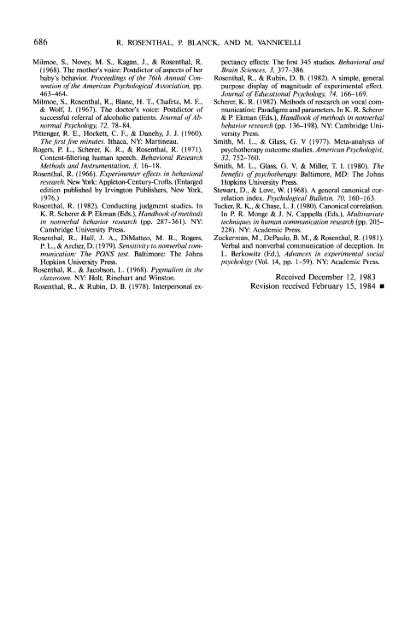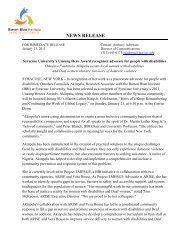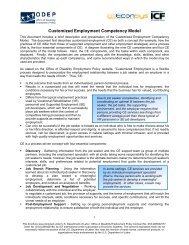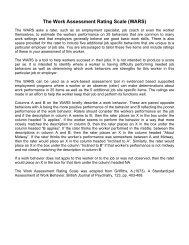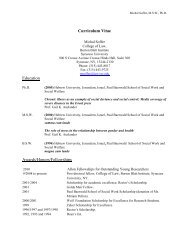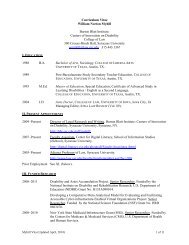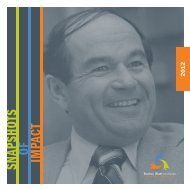Speaking to and About Patients: Predicting Therapists' Tone of Voice
Speaking to and About Patients: Predicting Therapists' Tone of Voice
Speaking to and About Patients: Predicting Therapists' Tone of Voice
You also want an ePaper? Increase the reach of your titles
YUMPU automatically turns print PDFs into web optimized ePapers that Google loves.
686 R. ROSENTHAL, P. BLANCK, AND M. VANNICELLIMilmoe, S., Novey, M. S., Kagan, J., & Rosenthal, R.(1968). The mother's voice: Postdic<strong>to</strong>r <strong>of</strong> aspects <strong>of</strong> herbaby's behavior. Proceedings <strong>of</strong> the 76th Annual Convention<strong>of</strong> the American Psychological Association, pp.463-464.Milmoe, S., Rosenthal, R., Blanc, H. T., Chafetz, M. E.,& Wolf, I. (1967). The doc<strong>to</strong>r's voice: Postdic<strong>to</strong>r <strong>of</strong>successful referral <strong>of</strong> alcoholic patients. Journal <strong>of</strong> AbnormalPsychology, 72, 78-84.Pittenger, R. E., Hockett, C. E, & Danehy, J. J. (1960).The first five minutes. Ithaca, NY: Martineau.Rogers, P. L., Scherer, K. R., & Rosenthal, R. (1971).Content-filtering human speech. Behavioral ResearchMethods <strong>and</strong> Instrumentation, 3, 16-18.Rosenthal, R. (1966). Experimenter effects in behavioralresearch. New York: Apple<strong>to</strong>n-Century-Cr<strong>of</strong>ts. (Enlargededition published by Irving<strong>to</strong>n Publishers, New York,1976.)Rosenthal, R. (1982). Conducting judgment studies. InK. R. Scherer & P. Ekman (Eds.), H<strong>and</strong>book <strong>of</strong> methodsin nonverbal behavior research (pp. 287-361). NY:Cambridge University Press.Rosenthal, R., Hall, J. A., DiMatteo, M. R., Rogers,P. L., & Archer, D. (1979). Sensitivity <strong>to</strong> nonverbal communication:The PONS test. Baltimore: The JohnsHopkins University Press.Rosenthal, R., & Jacobson, L. (1968). Pygmalion in theclassroom. NY: Holt, Rinehart <strong>and</strong> Wins<strong>to</strong>n.Rosenthal, R., & Rubin, D. B. (1978). Interpersonal expectancyeffects: The first 345 studies. Behavioral <strong>and</strong>Brain Sciences, 3, 377-386.Rosenthal, R., & Rubin, D. B. (1982). A simple, generalpurpose display <strong>of</strong> magnitude <strong>of</strong> experimental effect.Journal <strong>of</strong> Educational Psychology, 74, 166-169.Scherer, K. R. (1982). Methods <strong>of</strong> research on vocal communication:Paradigms <strong>and</strong> parameters. In K. R. Scherer& P. Ekman (Eds.), H<strong>and</strong>book <strong>of</strong> methods in nonverbalbehavior research (pp. 136-198). NY: Cambridge UniversityPress.Smith, M. L., & Glass, G. V (1977). Meta-analysis <strong>of</strong>psychotherapy outcome studies. American Psychologist,32, 752-760.Smith, M. L., Glass, G. V, & Miller, T. I. (1980). Thebenefits <strong>of</strong> psychotherapy. Baltimore, MD: The JohnsHopkins University Press.Stewart, D., & Love, W. (1968). A general canonical correlationindex. Psychological Bulletin, 70, 160-163.Tucker, R. K., & Chase, L. J. (1980). Canonical correlation.In P. R. Monge & J. N. Cappella (Eds.), Multivariatetechniques in human communication research (pp. 205-228). NY: Academic Press.Zuckerman, M., DePaulo, B. M., & Rosenthal, R. (1981).Verbal <strong>and</strong> nonverbal communication <strong>of</strong> deception. InL. Berkowitz (Ed.), Advances in experimental socialpsychology (Vol. 14, pp. 1-59). NY: Academic Press.Received December 12, 1983Revision received February 15, 1984 •


